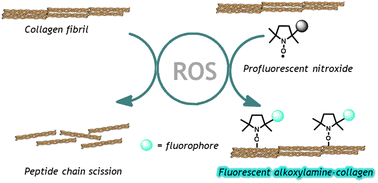Dual functional profluorescent nitroxides for the detection of reactive oxygen species and inhibition of collagen degradation during reassembly†
Abstract
High content of reactive oxygen species (ROS) in the human body leads to oxidative stress and serious health problems, such as cancer and cardiovascular or bone diseases. It is also one of the agents that cause collagen damage. Herein, detection of ROS, scavenging of formed carbon-centered radicals and inhibition of collagen fragmentation were performed in a single operation using newly synthesized profluorescent nitroxide PN1via a switch-on approach. Reassembly of acid soluble collagen (ASC) in the presence of hydroxyl and hydroperoxyl radicals, representatives of ROS, was monitored to study the efficiency of the PN1 probe. Self-assembly curves of collagen fibril solution were in accordance with differential scanning calorimetry (DSC) and scanning electron microscopy (SEM) observations, and indicated that PN1 efficiently inhibited the collagen chain scission. In order to prevent the leakage of the probe in materials, a PN2 monomer was successfully incorporated with MMA to form a profluorescent copolymer probe. Furthermore, PN1 and PN2–MMA copolymer probes offered high sensitivity of detection of ROS in the presence of collagen fibrils with detection limits of 1.1 and 2.7 μM, respectively. The mechanism of ROS detection and inhibition of collagen degradation by profluorescent nitroxides was proposed.



 Please wait while we load your content...
Please wait while we load your content...